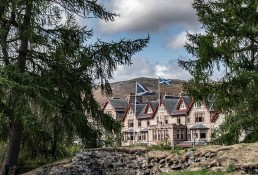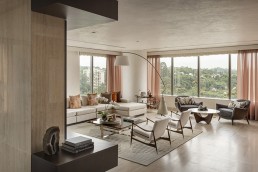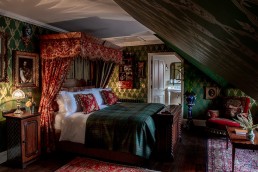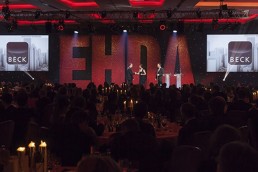REVIEW: The Fife Arms
Hauser & Wirth partners with Russell Sage Studio and Moxon Architects to transform a former Victorian coaching house in the Scottish Highlands.
Since its inception in 1856, The Fife Arms has long been a landmark in Braemar – the Aberdeenshire village home to one of the most famous Highland Games in Scotland. Set in the valley of Royal Deeside, deep in the Cairngorms National Park, the Victorian coaching house has been somewhat neglected in recent years, falling into a state of disrepair. Nevertheless, when first-time hoteliers Iwan and Manuela Wirth – the Swiss entrepreneurs behind contemporary and modern art gallery Hauser & Wirth – set eyes on the historic property, they were quick to spot its potential. Having transformed a nearby stately home into a private residence, bringing their expertise to The Fife Arms was the next natural step, and so the duo sought out an ensemble cast of architects, designers, craftspeople and artists to reinvent the property.
Inspired by the dramatic landscape, colourful stories and rich cultural connections to the village, the transformation of the hotel brings together a profound respect for local history, a love of art and a strong sense of community, channelling the owner’s passion for heritage and craft through 46 guestrooms and suites, a restaurant overlooking the River Clunie, a cocktail bar themed on Italian fashion designer Elsa Schiaparelli, and an eagerly-awaited village pub.
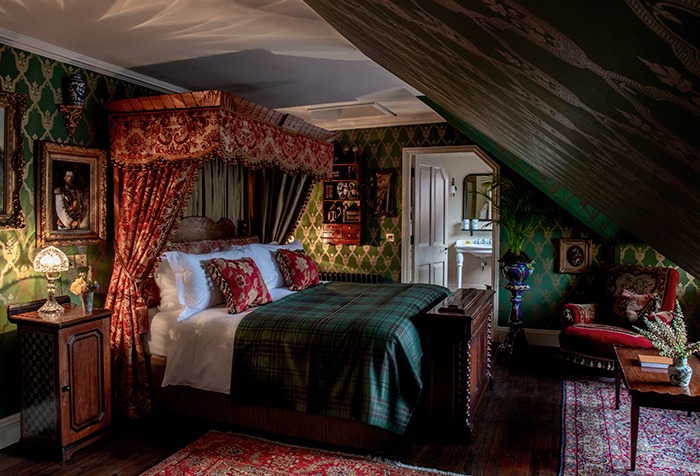
Tasked with masterplanning the project, Moxon Architects, a Crathie- and London-based practice, reinstated the entire building, preserving architectural details before elevating the functionality of the original space, reshaping its structure and extending at the rear to cater for new staff quarters. “We aimed to revive the landmark building through the careful restoration and discreet remodelling of the precious, historic fabric, whilst also dramatically improving the way in which the hotel operates,” says Aberdeenshire-born Director Ben Addy, who also works for The Cairngorms Trust and is a member of the Braemar Mountain Rescue.
Bringing his creative vision to the interiors meanwhile, designer Russell Sage echoes a strong local narrative through the layering of bespoke tweed, tartan and handprinted wallcoverings, which along with carefully chosen antiques and an extensive artwork collection, are woven into the fabric of the building. Sage, whose portfolio includes the likes of London’s Zetter Townhouse, The Goring and Kimpton Fitzroy, describes the project as the perfect scale for its “brave” owners, who he was introduced to through a friend: “The work that Iwan and Manuela have done in Bruton at Hauser & Wirth Somerset, turning a farm into an internationally recognised art gallery, sets the scene for what they have achieved here in Scotland,” he explains. “They were looking for someone to design a hotel that combines contemporary art with antiques, and to convey a sense of storytelling. Those three very things are my absolute passion and forte, so it couldn’t have been more fortuitous – it was an absolute dream project for me.
“Iwan and Manuela ultimately wanted to create a space that was incredibly faithful to Braemar, as the hotel is in the centre of the village and really means something to the local community,” Sage continues. “At its heart is a passion for sharing creativity and paintings as stories. It’s not an art gallery, but rather layered art that works in harmony with the landscape and views out of the window.”
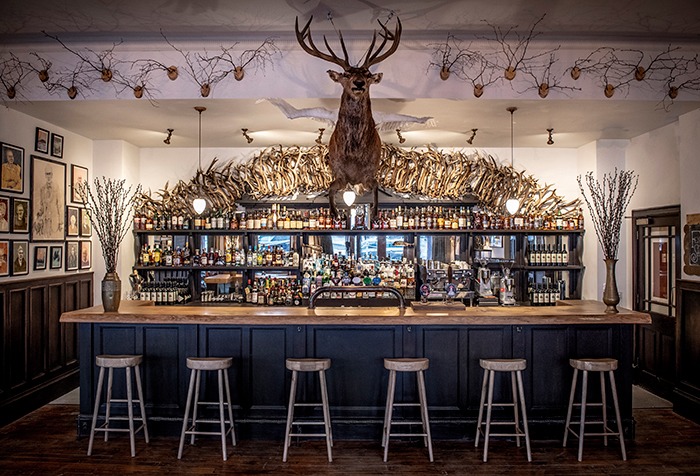
In keeping with the Wirth’s decades-long passion, art is central to the hotel’s DNA and becomes an integral part of the design story. From Louise Bourgeois’ spider sculpture in the rear courtyard to a collection of Victorian taxidermy exhibits, more than 14,000 pieces of art, antiques and objects are thoughtfully woven into every room, corridor and corner, each placed not merely to provide visual pleasure but also to enhance the narrative. Guests are greeted in the lobby by a monumental 19th-century mahogany and pine chimneypiece reaching over three metres in height – discovered on the Montrave Estate near the Scottish town of Leven. The tour de force was carved by Gerrard Robinson with depictions of scenes from the work of native lyricist and poet Robert Burns, while other British works include paintings by famed wildlife illustrator Archibald Thornburn, as well as a canvas by Dundee artist John Maclauchlan Milne, and a delicate watercolour of a stag’s head painted by Queen Victoria herself. Works by internationally-based artists such as Zhang Enli, Guillermo Kuitca, Subodh Gupta and Bharti Kher are also present in the form of large-scale site-specific installations, while American artist, writer and naturalist James Prosek was tasked with designing the hotel’s handsome coat of arms and logo for the village pub, newly christened The Flying Stag. Though the era-spanning spirit of The Fife Arms is perhaps best expressed in the beguiling contrast between two bespoke chandeliers; one fashioned – according to longstanding Scottish tradition – from antlers ethically sourced by Gareth Guy of The Horn Shop in Braemar, while the other has been created by Los Angeles-based artist Richard Jackson, whose colourful interpretation of the Scottish decorative classic is an assemblage of contemporary cast glass antlers lit from within.
During the renovation, a number of artists were invited to take up residence in Braemar and immerse themselves in the locale. Among them, Scottish luminary Alec Finlay was commissioned to create ‘Gathering’ – a poetic guide to the Cairngorms using place names and their underlying meanings to explain the landscape, ecology and lives that have been lived in the area; words and lines from the book were then carved into custom-made wooden headboards in a selection of guestrooms. Meanwhile, Gideon Summerfield, a recent postgraduate from London’s Royal School of Drawing, sketched portraits of the village’s several hundred residents as part of his ‘Characters of Braemar’ series, a selection of which hang in The Flying Stag, complementing black-and-white photographs taken at The Braemar Gathering by local photographer Steven Rennie.
Upstairs, guestrooms and suites feature bespoke furnishings as well as distinct décors that pay homage to a place, person, event or activity integral to the legacy of Braemar. Researched by consulting historians from Aberdeen University and translated into design elements, the stories honour celebrated figures like Robert Louis Stevenson, who began writing Treasure Island whilst in Braemar; and Frances Farquharson, the American fashion editor who married Captain Alwyn Farquharson of the neighbouring Invercauld Estate, while other guestrooms are a tribute to local characters including The Highlander, The Stalker, The Farmer and The Mountaineer.
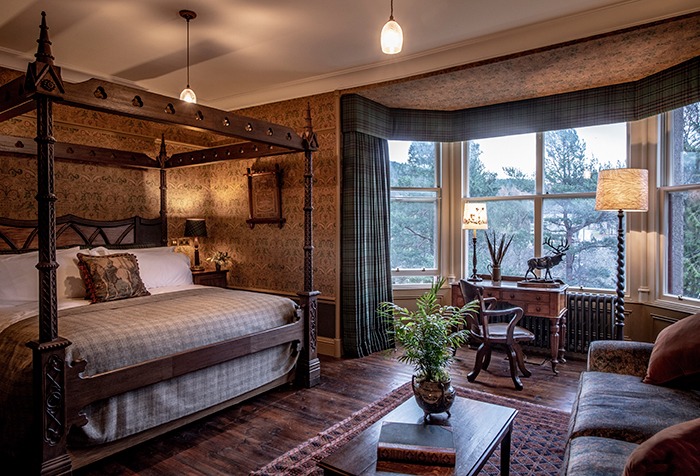
“Every space needed a story, so we sourced original items belonging to the real people,” Sage explains. “The Queen Victoria Suite has her own personal objects in it, while the Indian Suite houses items that belonged to Abdul Karim. What that fostered was an incredible energy, and layered over that was thousands of paintings, from the local watercolour painter to Picasso, Bruegel and Lucian Freud.”
The rhythm of the Highland seasons continues at the hotel’s main restaurant, The Clunie Dining Room, where Executive Chef and Scotsman Robert Cameron cooks signature dishes like Aberdeen angus sirloin and red deer ossobuco over the open flames of a fire pit, designed by Swedish Michelin-starred chef Niklas Eckstedt. Across the lobby, the project’s embrace of the locale is best illustrated by the restoration of the original public bar. A place where Braemar residents rub shoulders with visitors from further afield, The Flying Stag offers local beers, Scottish whiskies and spirits, while an oak bar hewn by Tom Addy, local building contractor and brother of architect Ben Addy, ensures that locals popping in for a pint are safe in the knowledge that the pub is representative of its surroundings.
Elsewhere, a garden designed by Chelsea Flower Show medallist Jinny Blom gracefully links the main building to a spa offering treatments inspired by the flora of Scotland, while a boot room provides equipment for guests looking to discover the nearby ancient castles, hiking routes and seasonal outdoor activities with local resident and Ghillie (concierge) Ros Evans, or trained gamekeeper Ben Carter. General Manager Federica Bertolini, who moved to the area three years ago, also curates a programme of regular cultural events centred on heritage, craftsmanship and contemporary art, including driving excursions with wilderness guide Ian Murray and local tours with Simon Blackett of Braemar Community Group.
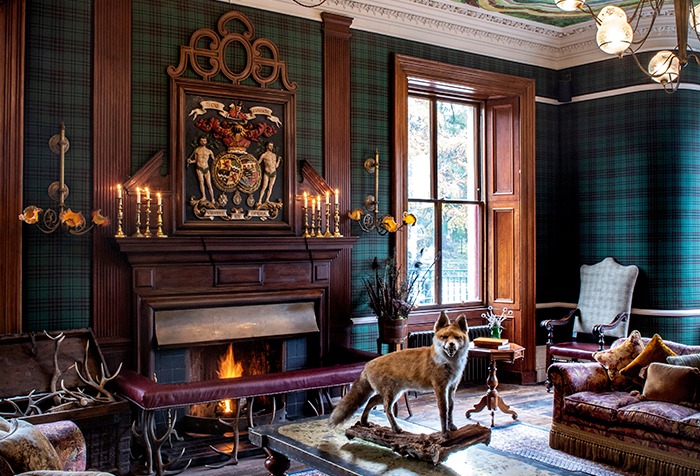
Four years in the making, the monumental transformation of The Fife Arms was most certainly demanding, even for someone with Sage’s experience: “The challenge was the sheer volume, as it’s bigger than anything we’ve ever completed before,” he observes. “It’s so rich, so carefully put together to ensure it is completely true to the story. But it’s not a museum, more a gloriously fun and silly place to be. We hope it leaves a huge impact on people.”
And leave an impression it does, not only reflecting the Wirth’s dedication to contemporary art but also informing visitors of their awe-inspiring surroundings and reclaiming its crown as the heartbeat of Braemar. For Sage, who describes the project as a “genuine career highlight”, The Fife Arms serves as an example of how today’s hotel must evolve: “Every guest is a critic, every guest is searching for more, and hotels need to deliver on that promise. Luxury is not enough anymore, everything is a bit of luxury; it’s about winning a bit of people’s memory and their love for a place.”
Words: Ben Thomas
Photography: © Sim Canetty-Clarke
This piece originally ran in Sleeper 84
Related Posts
11 October 2019
REVIEW: Four Seasons Hotel São Paulo
24 January 2019
The Fife Arms reopens in Braemar
21 January 2015
